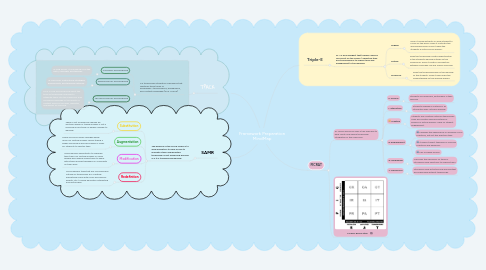
1. TPACK
1.1. is a technology integration framework that identifies three types of knowledge—technological, pedagogical, and content knowledge (a.k.a. TPACK)
1.1.1. CONTENT KNOWLEDGE
1.1.1.1. IS THE WHAT. It is made up of all the facts, concepts, and theories
1.1.2. PEDAGOGICAL KNOWLEDGE
1.1.2.1. IS THE HOW. instructional strategies, assessments, and teaching methods
1.1.3. TECHNOLOGICAL KNOWLEDGE
1.1.3.1. THIS IS THE KNOWLEDGE about the tools of technology and how to integrate them into the classroom. also included knowledge of the quality of content found in the apps, websites, and games for learning.
2. SAMR
2.1. The purpose of the SAMR model is to allow educators to have a scale to evaluate if their implemented technology is just enhancing learning or if it is transforming learning.
2.1.1. Substitution
2.1.1.1. There is not a beneficial change. Ex: Writing a paper or typing a paper is not a involving a functional or helpful change to learning.
2.1.2. Augmentation
2.1.2.1. There are some useful changes being done. Ex: Writing a paper versus typing a paper and using a word processor in order for students to identify their
2.1.3. Modification
2.1.3.1. Gives learners opportunity to redesign their tasks. Ex: Writing a paper or using google docs which allows them to share with others and get feedback in comments on their work.
2.1.4. Redefintion
2.1.4.1. Gives learners tasks that are inconceivable outside of technology. Ex: Creating educational films with music and special effects, etc. to keep education interesting and memorable.
3. Triple-E
3.1. Dr. Liz Kolb suggest that teachers should focus first on the lesson / objective then pull technology in to support and add engagement to the learning.
3.1.1. Engage
3.1.1.1. Does it cause distracts or allow student to focus on the work? Does it motivate the learning process? Does it make the students a active social learner?
3.1.2. Extend
3.1.2.1. Does the technology create opportunities in the students learning outside of the classroom? Does it create a connection between everyday life and school learning?
3.1.3. Enchance
3.1.3.1. Does the technology help in the learning of the student? Does it help make the understanding of the learning easier?
4. PICRAT
4.1. Dr. Royce Kimmons uses a two way grid to help clarity and define technology integration in the classroom.
4.1.1. P: Passive
4.1.1.1. Students are observers, bystanders in their learning.
4.1.2. I: Interactive
4.1.2.1. Students engage in material in an interactive way; actively learning.
4.1.3. C: Creative
4.1.3.1. Students are creating materials themselves. They are creative learners instead of passive or active learners. Apex of student engagement.
4.1.4. R: Replacement
4.1.4.1. Changes the appearance or dressing of our practices, but not the practice itself.
4.1.4.2. It doesn't affect teaching or learning practices and behaviors
4.1.4.3. Can increase access.
4.1.5. A: Amplifying
4.1.5.1. Improves the efficiency of tasks or introduces new functions to original tasks.
4.1.6. T: Transforms
4.1.6.1. Introduces new activities and learning that are impossible without technology.
